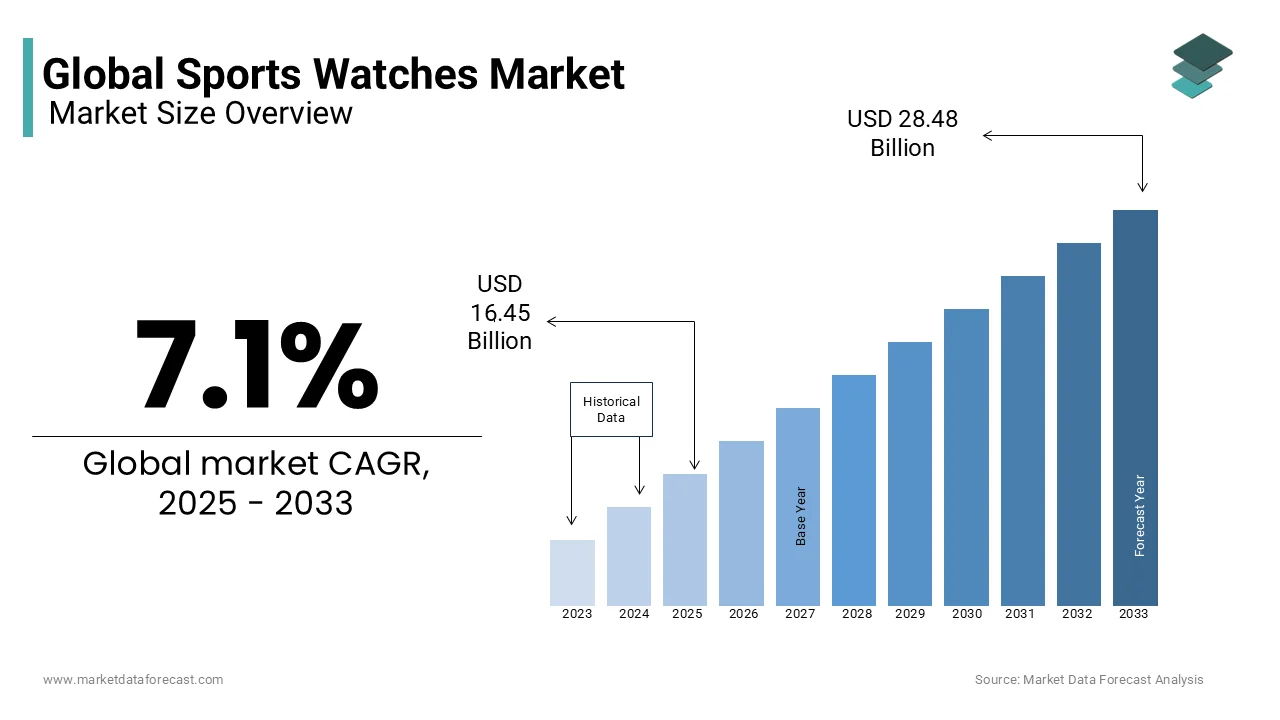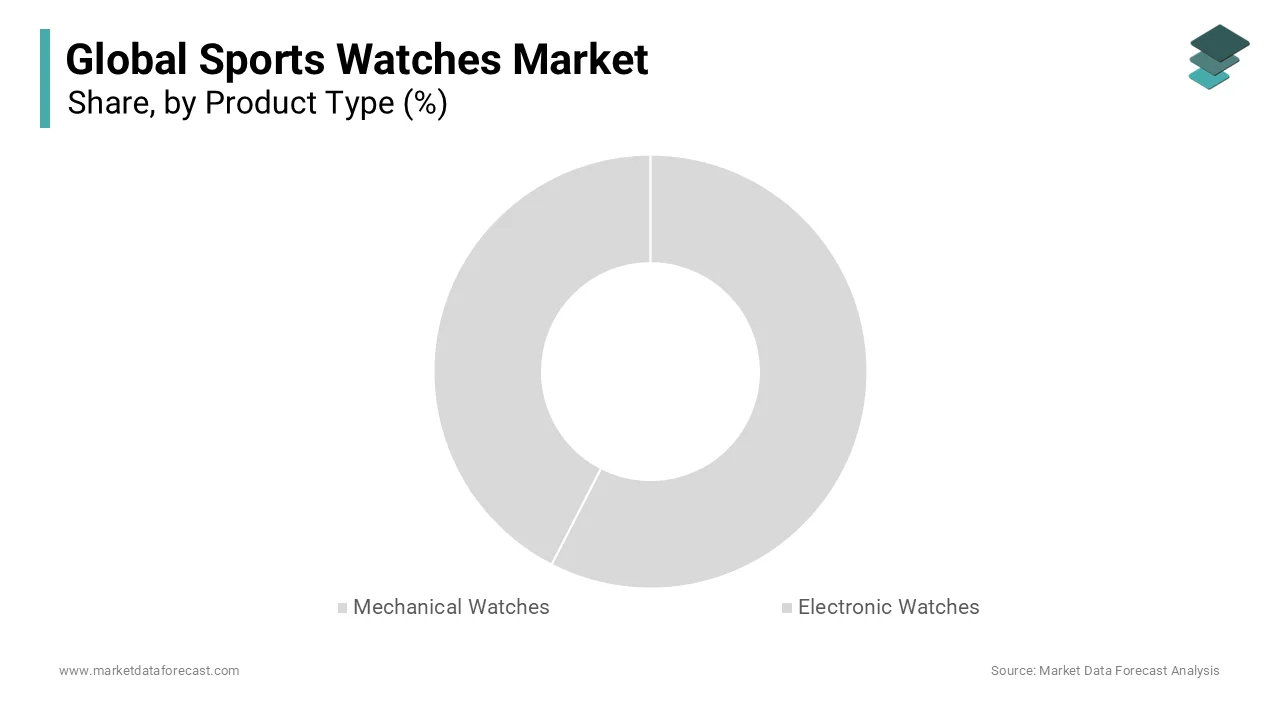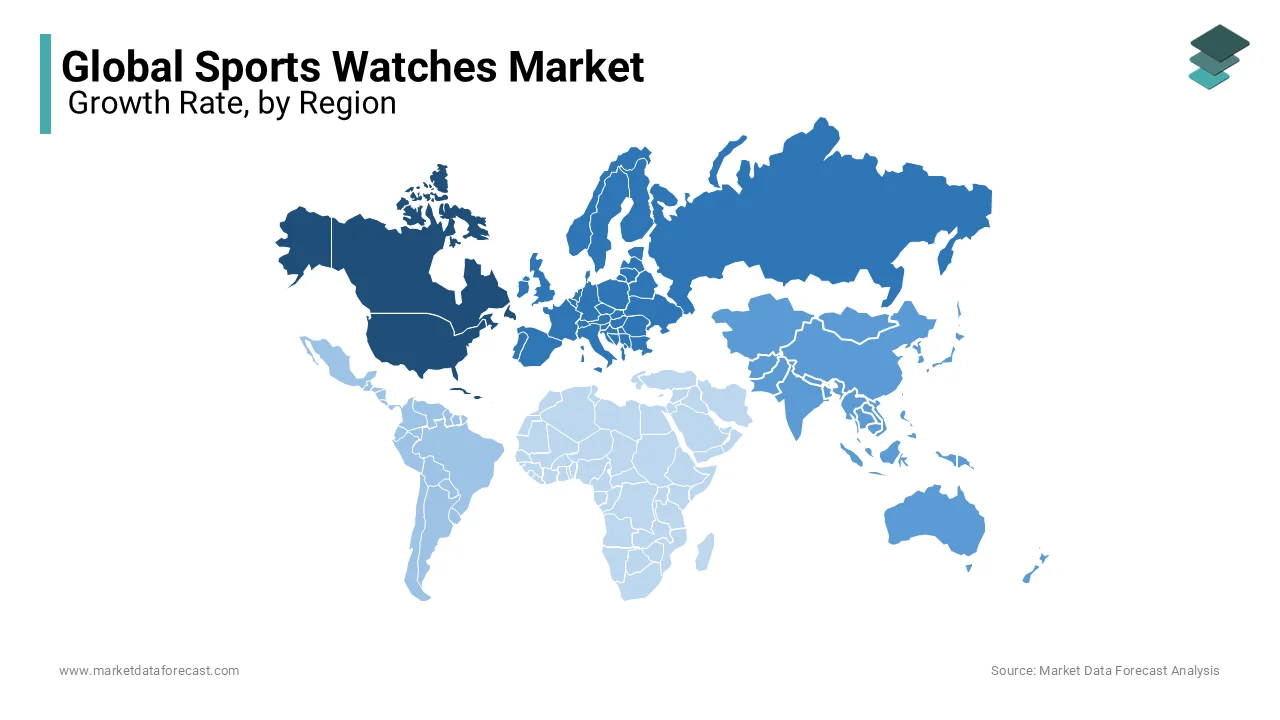Global Sports Watches Market Size, Share, Trends, & Growth Forecast Report Segmented by Product Type (Mechanical Watches and Electronic Watches), End-User (Male and Female), Distribution Channel (Offline Retail Stores and Online Platforms) and Region (North America, Europe, Asia Pacific, Latin America, and Middle East & Africa), Industry Analysis From 2024 to 2033
Global Sports Watches Market Size
The size of the global sports watches market was valued at USD 15.36 billion in 2024. The global market is anticipated to be worth USD 28.48 billion by 2033 from USD 16.45 billion in 2025, growing at a CAGR of 7.1% from 2025 to 2033.

Sports watches are more durable, reliable and useful. Sports watches are timepieces made primarily for athletes to wear while participating in sports. More importantly, it must have functional functions that are also comfortable on the user's wrist and easy to read when performing various activities or sports. Chronographs, for example, are watches that record split-second timing of events that occur over short periods of time; this feature may be useful in determining how long an athlete can sprint at peak speed or which day they completed the most laps around a pool.
Even when there is low light, the watch should be easy to read. Some timepieces feature 'lume,' which is effectively glow-in-the-dark paint put to them. Other timepieces, particularly digital watches, may have an LCD illumination feature that illuminates the entire dial screen. Water resistance of 200 meters is standard for sports watches, however, it is not always the case. This is the standard depth rating for a true 'dive watch' appropriate for actual diving, though swimming or being caught in the rain would also suffice. A screw-down crown is common on a watch with a metal case, such as stainless steel. The watch's crown (the small 'knob' used to set the time) screws into the case threads.
MARKET DRIVERS
Increased Use of Timepieces for Sports & Fitness
The increased use of timepieces for sports & fitness is one of the primary factors propelling the growth of the global sports watches market. Over the last several years, the number of consumers partaking in sporting activities or working out at gyms has expanded dramatically and this trend is likely to fuel in the coming years and boost the growth rate of the global market. The rise in global awareness of health and fitness, as well as increased demand for high-quality watches with features such as heart rate monitoring and GPS tracking, is contributing to the growth of the global sports watch market.
The growing disposable income as a result of increasing work opportunities and population spending capacity is further fuelling the growth rate of the sports watches market. Countries with substantial populations living below the poverty line would be able to rise beyond it over time, resulting in an increase in their purchasing power and consumer demand. Rising investments in research and development operations, the entry of new companies, product innovation, technological advances, effective resource allocation, and growing competitiveness among company rivals to extend its regional and client base are all contributing to the industry's success. Favorable government policies and incentives and favorable regulations are expected to determine the growth of the sports watch market.
MARKET RESTRAINTS
High Level of Skill and a Large Initial Investment
Smartwatches require a sophisticated circuit structure due to the integration of multiple components such as sensors, displays, and other components into a compact device. The gadget contains several very small semiconductor devices with a core diameter of 10 micrometers. Because control ICs are only a few hundred nanometres thick, it becomes difficult to combine multiple components into a single device. The precision required for design and development necessitates a high level of skill and a large initial investment. Furthermore, smartwatches are regarded as high-end wearable devices. As a result, the high cost of these smart gadgets stifles global market growth to some extent.
REPORT COVERAGE
|
REPORT METRIC |
DETAILS |
|
Market Size Available |
2024 to 2033 |
|
Base Year |
2024 |
|
Forecast Period |
2025 to 2033 |
|
CAGR |
7.1% |
|
Segments Covered |
By Product Type, End-User, Distribution Channel, and Region |
|
Various Analyses Covered |
Global, Regional & Country Level Analysis, Segment-Level Analysis, DROC, PESTLE Analysis, Porter’s Five Forces Analysis, Competitive Landscape, Analyst Overview of Investment Opportunities |
|
Regions Covered |
North America, Europe, APAC, Latin America, Middle East & Africa |
|
Market Leaders Profiled |
Casio, Timex, Citizen, Victorinox, G-Shock, Seiko, Fossil, Luminox, Movado, Nixon, and others |
SEGMENTAL ANALYSIS
By Product Type Insights
Based on product type, the electronic watches segment is anticipated to hold the major share of the global market during the forecast period due to the various features offered by them that are not present in mechanical watches. Electronic watches are powered by a rechargeable battery and have electronic components. The gadgets may be customized to display the time in various locations across the world, making them more useful when traveling or living abroad. GPS, heart rate monitors, and other features are also available. Whereas mechanical watch movements require to be in constant motion to wind up their springs, which can be accomplished by hand-winding or arm movement.

By End User Insights
Based on end-users, the male segment is estimated to account for the largest share of the global market during the forecast period. The male customer base is expected to have a dominant share of the market and the size of the male customer pool is larger. However, the features offered in sports watches for males and females are almost the same. Because of their sturdy construction and water resistance, they are frequently worn by people while exercising or participating in sporting activities. The watches include exercise tracking (calories burnt), a heart rate monitor (MVP), and a sleep tracker, among other capabilities (Alert).
By Distribution Channel Insights
Based on the distribution channel, the online segment is anticipated to account for the leading share of the global market in the coming years. For the forecast period, online platforms will witness higher sales because of an increase in smartphone usage and internet penetration. After the COVID-19 pandemic, consumers have adopted online shopping and prefer to stay home and purchase all items. Online shopping is much more convenient, faster and cost–efficient. Various e-commerce platforms offer a variety of discount schemes that attract consumers. Thus, people now choose online websites over offline retail shops.
REGIONAL ANALYSIS
Based on the region, North America is expected to hold a significant share of the global market during the forecast period. Increased disposable income and an increase in the employment rate, among other factors, are credited with the expansion.

Following that, Europe is predicted to hold a high proportion of the global sports watch market. The increase can be ascribed to improving economic conditions, high disposable income per capita, and an expanding population base in key nations like Germany, France, the United Kingdom, Italy, Russia, and Spain, among others.
The Asia Pacific region is expected to develop at a substantial CAGR over the forecast period, owing to a growing awareness of health and fitness among individuals, as well as growing trend changes toward healthier lifestyles and increased disposable income per capita.
KEY PLAYERS IN THE MARKET
Companies playing a major role in the global sports watches market include Casio, Timex, Citizen, Victorinox, G-Shock, Seiko, Fossil, Luminox, Movado and Nixon.
RECENT HAPPENINGS IN THE MARKET
-
Casio introduced a pair of new sports watches manufactured from biomass plastics, which are generated from castor beans and corn. The company wants to replace petroleum-based polymers with something more environmentally friendly.
-
Apple is considering adding a new Apple Watch model aimed at athletes, extreme climbers, and hikers to its array of Apple Watch models. This theory is supported by Apple's latest waterproofing patent application.
MARKET SEGMENTATION
This research report on the global sports watches market has been segmented and sub-segmented based on product type, end-user, distribution channel and region.
By Product Type
-
Mechanical Watches
-
Electronic Watches
By End User
-
Male
-
Female
By Distribution Channel
-
Offline Retail Stores
-
Online Platforms
By Region
-
North America
-
Europe
-
Asia Pacific
-
Latin America
-
Middle East and Africa
Frequently Asked Questions
What are the major trends driving the growth of the sports watches market?
Key trends include increasing demand for smartwatches with fitness tracking features, advancements in wearable technology, rising health and fitness consciousness among consumers, and the integration of AI and IoT in sports watches for better user experience and real-time data tracking.
What are the most popular types of sports watches?
The most popular types of sports watches are smart sports watches, GPS-enabled watches, and heart rate monitoring watches. Smart sports watches that offer multi-sport tracking, advanced analytics, and smart notifications have gained widespread consumer popularity.
How is the sports watches market affected by technological advancements?
Technological advancements are a key driver of market growth. Innovations such as long-lasting batteries, high-precision GPS, advanced biometric sensors, and smartwatch integrations have significantly enhanced the appeal of sports watches, attracting both fitness enthusiasts and professional athletes.
What role does e-commerce play in the sports watches market?
E-commerce plays a crucial role in the distribution of sports watches globally. Online platforms like Amazon, Alibaba, and specialized sports retailers enable companies to reach a broader audience. E-commerce offers convenience, a wider selection of models, competitive pricing, and detailed customer reviews, all of which have driven higher sales in recent years.
Related Reports
Access the study in MULTIPLE FORMATS
Purchase options starting from $ 2500
Didn’t find what you’re looking for?
TALK TO OUR ANALYST TEAM
Need something within your budget?
NO WORRIES! WE GOT YOU COVERED!
Call us on: +1 888 702 9696 (U.S Toll Free)
Write to us: [email protected]